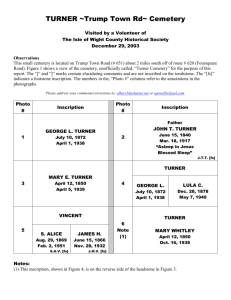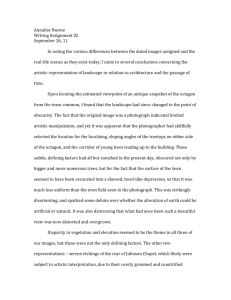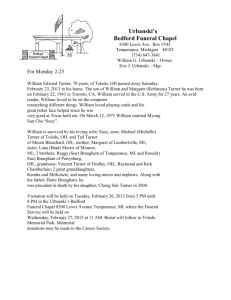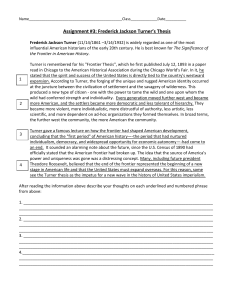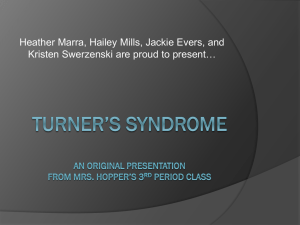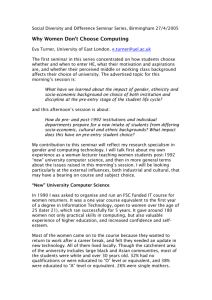WILLIAM BARWELL TURNER: THE LATER YEARS - Microscopy-UK
advertisement
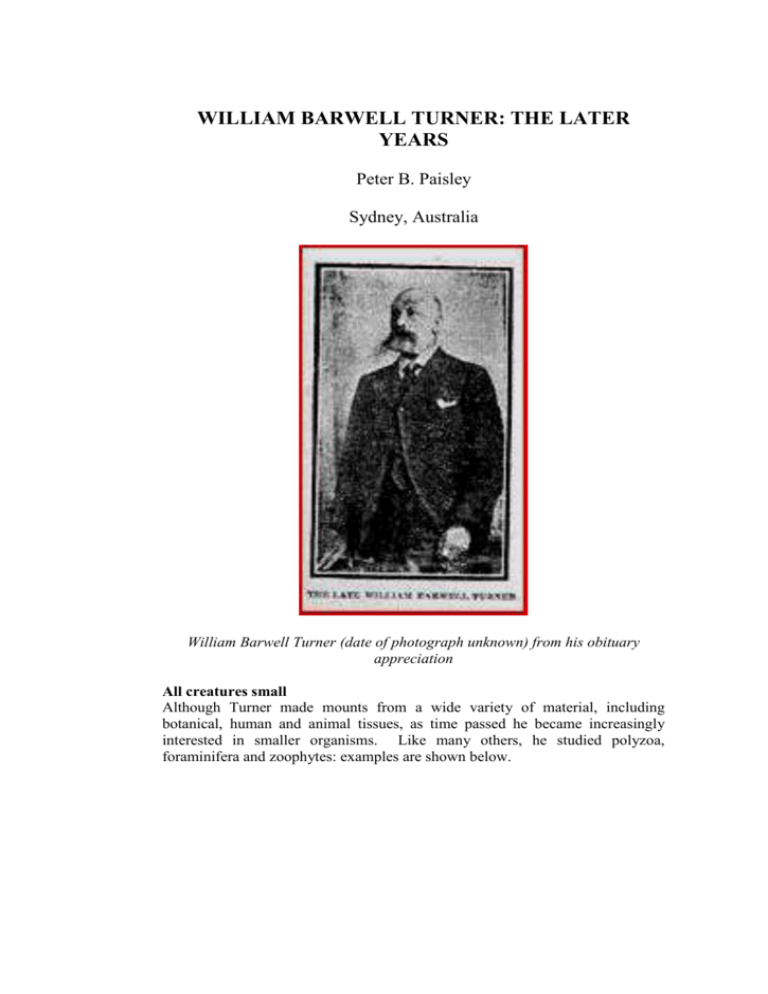
WILLIAM BARWELL TURNER: THE LATER YEARS Peter B. Paisley Sydney, Australia William Barwell Turner (date of photograph unknown) from his obituary appreciation All creatures small Although Turner made mounts from a wide variety of material, including botanical, human and animal tissues, as time passed he became increasingly interested in smaller organisms. Like many others, he studied polyzoa, foraminifera and zoophytes: examples are shown below. As a chemist and brewing expert, it would be strange had he not studied fungi, and some are shown below. The entry below from the “notices to correspondents” section appeared in the February 1886 Science Gossip, in reply to a query to the editor: This is probably our preparer: I have found no other trace of him in the queries, notices or exchange sections of Science Gossip, apart from a brief acknowledgement of his paper for the Royal Microscopical Society on new and rare desmids in 1879. The adjacent references to “Grevillea” and Cooke are probably significant, since Turner refers to both in Algae (p.70), in the same note. (As in other articles, I generally abbreviate the title of Turner’s book). I have described Turner’s chemistry only sketchily – Micscape readers are interested in microscopy. But as one would expect, he made chemical mounts, and some are illustrated below. I include a mount of Japanese paper: he mounted dendritic spots on paper more than once, and was concerned with whether they were caused by inferior quality paper. By an uncanny coincidence, I found a dendritic spot on a page of one of my copies of Science Gossip while I was writing this article. The writer’s own dendritic spot, in Science Gossip, February 1884 Turner’s “road to Damascus” moment A voracious reader of scientific literature and a good Latinist, Turner chanced on a Swedish paper (in Latin), P.M. Lundell’s De Desmidiaceis quae in Suecia inventae sunt: observations criticae (Nova Acta Reg. Soc. Scient., Upsala 1871.) Already much interested in algae, this paper inspired Turner’s concentration on desmids. Not long after arrival in Leeds, he started his magnum opus on algae, particularly desmids. He corresponded with many Scandinavian workers, and concludes Algae Aquae Dulcis Orientalis thus: Finally, I venture to express my sense of the great indebtedness of British Algophiles to Scandinavian authors, whose great erudition is only equalled by their courtesy and generosity. It was heartfelt praise: despite practical backing from the Royal Microscopical Society, Turner struggled to get his book published in the UK, and it eventually appeared in 1892 in Stockholm, due to the influence of his Scandinavian friends and colleagues. Adversity and perseverance From around 1880, Turner’s health gradually deteriorated. His obituary specifies varicose veins, adding that in 1909 he suffered an amputation. The drastic outcome indicates dangerous complications. Varicose ulcers may get infected – no small threat in a pre-antibiotic era; deep vein thrombosis could cause cardiac or pulmonary embolism with atelectasis and further infection. The 1901 census shows him retired and incapacitated – however, what persisted was long in causing loss of a limb, nor did he die until 1917. Late onset diabetes was poorly appreciated (if at all) in those days: hypertension was inadequately defined and treated, and the significance of cholesterols was unknown. Any would add cumulative circulatory damage to areas of venous stasis and ulceration, as well as exacerbating any cardiac problems. His death certificate quotes the common final blow – pneumonia - with “arterial insufficiency” as the underlying condition. This latter vague diagnosis supports most of the above suggestions, and he was an inveterate pipe smoker, which could not have helped. On varicose veins, I do not know what was done. A professional chemist may have favoured the sclerosing injection starting to gain favour in the 1870s and 80s: long term however this was less successful than ligation. While rare, malignancy may occur in chronic varicose ulcers. Without family or hospital records, one can only make educated guesses: certainly, amputation is not a usual outcome due to varicose veins, nowadays at any rate. His obituary appreciation comments, His health broke down about 1891. Since that time he had been a chronic invalid……and current events, always keen and unflagging. Added to this was the frustration of failing to find a British publisher, but he persevered until his book was finally ready for his Swedish publisher in October 1892. Given that this was already 5 months since his corn exchange business had been gazetted for debt, here was a man who lived up to his motto – ne cede malis. Turner’s artistry Turner made many fine lithographs of heraldry, which he coloured himself: some are in the Thoresby Society’s library. Examples are shown below. He also illustrated his own book. Unlike (say) those of Ernst Haeckel, or his own heraldic work, his scientific drawings are unembellished, striving for accuracy rather than stylistic flourish, as below. In his articles for the Naturalist he often did his own lithography, but supervising this would have been impractical at the publication distance of Stockholm. Turner drew all the illustrations for his book – they were lithographed by W. Schlachter of Stockholm. One Victorian artistic genre was arranged mounts, and Turner tried his hand at some. He seems to have visited Ireland in July 1880: if sightseeing was on his agenda so, as always, was specimen collecting. In Galway, even a graveyard provided material: nor did he ignore other local resources, since a wooden slide (a most unusual medium for him) looks like Irish oak. Most material was gathered by him, but one slide shown below was mounted from material given to him by “W. Gray”. This must be William Gray, sometime president of the Belfast Field Naturalists’ Club, who may have shown him W.A. Firth’s arranged work. Turner’s Irish mounts Colleagues, correspondents and specimen suppliers One likely source of material was himself, or his eldest son (also named William Barwell Turner). Turner slides are rarely signed: when they are, it is with initials in a distinctive style. Three examples are shown below, along with another slide on which the initials WBT are much more consistent with the way material source is often specified. The slide on the left has initials characteristic of Turner’s indication of specimen donors. If he wanted human blood cells, what more convenient than to sample them at home? Turner had many collaborators: I have already mentioned William Gray. The slides below, prepared from specimens from Birmingham, are interesting. The pebble slide is undated, but another, dated 1881, is made from a specimen obtained by James Abbott from a tree in the same road. Abbott and Turner collaborated in mounting a variety of material during their time in the Leeds club. My conjecture is that Turner and Abbott were at a meeting of the Birmingham Natural History and Microscopical Society, where Turner’s friend A.W. Wills was a member and frequent presenter of communications on algae. I have been unable to discover the significance of Moseley Road, which today is full of modern buildings, with few trees, most of which look like recent plantings. Presumably redevelopment, accelerated by the Luftwaffe, has been responsible. It may be that one of Wills’ industrial ventures had its premises there, or nearby (this was not his home address): from directories of the time, the street seems replete with light and medium industrial works. One of Turner’s early major activities for the Leeds club, duly reported in the Naturalist, was his part in the three-man butterfly hunting team of Abbott, Emsley and Turner. All three made their own mounts, with a variety of subjects. James Abbott and Fred Emsley , like Turner, had wide microscopical interests, as can be seen in the slides shown above. The most distant contact was William M. Maskell, of Christchurch, New Zealand. Maskell was an ardent anti-Darwinist, while Turner accepted evolutionary theory: despite this, they enjoyed an amicable relationship, and Turner (Algae, pp.131-2) names a species, Staurastrum Maskellii, in his honour, referring to him as “my friendly correspondent”. Maskell reciprocated Turner’s gesture and named Cosmarium Turnerianum after him, saying, I have ventured to attach to this plant the name of Mr. W.B. Turner, who has been kind enough to give me much help. Cosmarium Turnerianum, from the illustrations to Maskell’s 1888 paper read to the New Zealand Institute. James Perry was a sea captain with a home base in Liverpool, who voyaged widely on the S.S. Humboldt, in the Atlantic, the Mediterranean, the Caribbean and elsewhere: he died at sea in 1879. He was an enthusiastic naturalist and microscopist and an associate member of the Liverpool Literary and Philosophical Society: associate members were limited to twenty-five, including several sea captains. He brought back rare Brazilian fish for the Liverpool aquarium, and obtained many dredged diatoms and foraminifera, as well as rare Brazilian beetles captured while on shore. He designed his own microscopical aids, including an erecting glass to reverse inverted images, making manipulation of specimens easier, and added gum camphor to paraffin for brighter lamp illumination. He made his own slides, often discussing the mounts with Frederic Kitton, and offered material to many others for mounting, witness his advertisement (Sept.1870) in Science Gossip Kitton (Science Gossip, Feb. 1872) commends Perry’s use of nitric acid to reveal hitherto unknown features of foraminifera, and (Science Gossip, Apr.1873) says that many were indebted to Perry for supplying “rare and beautiful species of diatomaceae” for mounting. Turner may have responded to the notice above, and he was certainly well able to offer a wide variety of mounts in exchange. The slides below acknowledge Perry as the source of material. Looking through the lists of 25 associate members of the Liverpool society in various years, the majority were always sea captains – presumably because they brought back exotic material for mounting by members, or for wider distribution to those who requested it. Turner was president of the Leeds Naturalists’ Club, and active in the Yorkshire Naturalists’ Union, around the time of Perry’s death, and we know he was an avid correspondent with many others both at home and abroad. The slides illustrated below are more than likely to have been made from material reaching the Liverpool society via Perry, or other sea captains. With the passage of time, the Liverpool society may have been unaware which captains were specifically involved in some of their stock, otherwise Turner would probably have acknowledged the source with initials or names. Otto Norstedt, who was related to Linnaeus’ family, worked in Lund and travelled widely – as far as Australia and New Zealand – in search of desmids and characeae. I do not know whether Turner visited Scandinavia, but I think Norstedt came to Leeds; at any rate they met, and Turner singles him out for special mention in the foreword to his book, which concludes, I must tender my grateful acknowledgement of assistance and kindly counsel received from my good friend Dr. Otto Norstedt, of Lund. A secretary of the Leeds Naturalists’ Club, James Addyman, played an important role here: Addyman was Swedish and Norwegian Vice-Consul in Leeds, and visited both countries from time to time. Meetings between Addyman, Norstedt and Turner probably occurred in the Addyman and Turner homes. Addyman brought back specimens for Turner to mount, for instance from Norstedt, or the Stockholm Riks-Museum via the generosity of Gustaf von Lagerheim. Some slides mounted by Turner of Swedish and Norwegian material, supplied to him by Norstedt, are illustrated below (to make the labels legible, my illustration cannot also show the specimens). Scandinavian material supplied by Otto Norstedt and mounted by Turner: the labels bear Norstedt’s initials Turner’s oldest friend and fellow researcher was probably Arthur Winckler Wills: like Turner he was from Birmingham and an FCS: he was an industrialist, with microscopy as a major ancillary occupation, and had a keen interest in fresh water algae. He was one of the editors of A Dictionary of Chemistry (1863), and commonly referred to as “WW” (another editor had the initials AWW), as below (from the dictionary). Turner, familiar with the chemical literature, presumably thought of him as “WW”. Wills became president of the Birmingham Naturalists’ and Microscopical Society in 1871, and contributed often to the Midland Naturalist, with many papers on fresh water algae, and other subjects. Turner (Algae, p.53) names Cosmocladium Willsianum in his honour. The material on the slide above may have been gathered for Turner by Wills on a visit to Yorkshire: Cullingworth is not very far from Leeds, but far enough to present difficulty for a man with deteriorating health and varicose veins, if the specimen was mounted while Turner was at work on Algae. As Turner says in his introduction (p.10), Long continued sickness delayed my work. An obvious alternative is that the initials on the Cullingworth slide are those of William West, a pharmacist and Turner’s friend of later years, who lived in Leeds during Turner’s time there, subsequently moving to Bradford (Cullingworth is nearby). Turner’s obituary says, He studied the fresh water algae in particular, corresponding with another Leeds man, the late William West, of Bradford. It is a tantalisingly vague statement in the context of any possible mounting collaboration between the two men. West, in addition to acting as Tempère’s agent for slide sales, also made mounts himself, and an example is shown below. A slide by William West of Bradford There seems no way of deciding, on present evidence. WW initials also cause me to reconsider the provenance of some of Turner’s earliest mounts. In my first article I guessed that Turner slides, made at Aldeby, showed insect specimens from Waveney Woods (“WW”). While Turner almost certainly got his introduction to the microscope and its revelations at school, Wills may have urged him to extend his activities to mounting. Several years Turner’s senior, Wills may have been Turner’s earliest mentor in slide preparation. Much later, Wills, himself an expert on fresh water algae, was probably a major influence on Turner to pursue similar research. There is however a much more likely provenance for the WW initials on Turner’s (1860) Aldeby mounts. Aldeby is a very small place: even today its population is only a few hundred. In 1860, any local naturalist/microscopist in the village must have been well known, and would have attracted Turner’s attention. By 1862, just such a person was considering converting his enthusiasm for microscopy into a full time occupation, and seeking a subscription list for the slides he made. Insects were among the material he collected, and we know Turner mounted insects at Aldeby. I shall let the extract from the Quarterly Journal of Microscopical Science, (1862, below) speak for itself. I think this must be the WW of Turner’s Aldeby aphid mounts. I should mention here another addition to what I have previously written. Turner’s obituary mentions work in Devon. Slides he made in Weymouth presumably originated there, on the English Channel coast. There was a ferry service from Weymouth round Cornwall and into the Bristol Channel, which Turner probably used to travel between his consultancies in Wales and Somerset. Given his fiancée’s residence in Bruton, he may have done so several times, but dates on the slides in my collection cannot confirm or deny this. Wallich George Charles Wallich is not often prominent in recent historiography: a perfunctory entry in the Dictionary of national Biography (below) is less than effusive. Accounts of nineteenth century deep ocean biology tend to start with Edward Forbes’ azoic theory, ending with its alleged refutation by William Carpenter or more especially Wyville Thomson. From Forbes’ idea that oceanic life was impossible below a few thousand feet, one reaches contradictory evidence, particularly from the Lightning, Porcupine, and Challenger voyages, that life exists at extreme ocean depths. In between, Wallich’s contributions seem to have receded into comparative obscurity. Yet it was his books of 1860 and 1862 which produced a comprehensive challenge to Forbes’ theory, at the time regarded by many almost as gospel. From notebooks written on board the Bulldog, Wallich “dipped a toe in the water” with a short volume, Notes on the Presence of Animal Life at Vast Depths in the Sea: with Observations on the Nature of the Sea Bed, as Bearing on Submarine Telegraphy, circulated privately in 1860. As he says there (p.7), Certain erroneous statements…..have been so authoritatively put forth, that they command an almost unquestioned belief. Amongst the more prominent of these may be mentioned the assertion, that animal life cannot, by any possibility, be maintained at a depth exceeding 500 fathoms. It was a robust tilt at Forbes’ azoic theory. Actually, long since, as Wallich noted, evidence from the two Ross expeditions had yielded results which contradicted the azoic theory: it wasn’t the first time facts got brushed aside in favour of received doctrine, and it won’t be the last. Clearly though it was tempered with some nostalgic regret that Wallich overthrew the theory of his sometime colleague and friend. In his (1862) The North Atlantic Sea Bed: Comprising a Diary of the Voyage on board HMS Bulldog, in 1860, he pays tribute to the youthful Edinburgh friendship, thus (p.150): I cannot refrain from here paying my humble tribute of admiration and respect to a lamented friend and college-mate. The first time I ever saw a dredge put down was in the Firth of Forth, in company with Edward Forbes, nine and twenty years ago. Wallich drew the illustrations for his 1862 book (and did the lithography himself). Creatures from the deep: foraminifera dredged, drawn and lithographed by George Charles Wallich Following his return to England from the Bulldog voyage, Wallich was pointedly snubbed by some in the scientific establishment, in particular by Carpenter, (who had a talent for vituperation), and he felt the insult keenly. Many of his slides (at least around a thousand) survive, gathering dust, uncelebrated and underdocumented, in museum cupboards in Oxford. Around 15% of the entire Royal Microscopical Society’s stock there, they include many from the Bulldog voyage – surely, in toto, one of the most significant microscopical survivals from the nineteenth century. The Rev. J.B. Reade FRS, who admired Wallich’s work on both desmids and deep ocean biology, wrote to him several times, assuring him that the Royal Microscopical Society valued his work and imploring him to rescind his resignation from membership. Wallich may have set up in practice as a physician and/or surgeon in London. Census entries from 1861 onward however list him as retired, as below. From the 1871 census Perhaps his army pension wholly sustained him, but that may be doubtful, given his large household in Kensington – not the cheapest inner London location. From the same 1871 census (following page) His varied skills enabled him to set up a photographic studio, where duplicate prints could readily be produced. Reade himself made some of the very earliest photographs anywhere, so it seems no coincidence – given his regret at Wallich’s treatment - that he chose him to produce his “cartes de visite” as president of the Royal Microscopical Society. Front and rear of Wallich’s “carte de visite” for Reade The term carte de visite was patented by the French photographer Disdéri: seldom produced in visiting card format in England, these were in fact generally destined for photograph albums, and from 1860 onwards they enjoyed a huge market, amplified by Queen Victoria’s patronage. Due no doubt to Reade’s influence, Wallich probably acquired considerable clientele among the scientific and professional communities, and beyond, for these portraits – this probably became a significant source of income. The photograph of Turner in his Yorkshire Weekly Post obituary resembles a carte de visite, and may have been reproduced from one made for Turner by Wallich. Turner and Wallich A remarkable man in every way, Wallich deserves better from historians, and I’m glad I’ve been able to illustrate a desmids slide mounted, by Turner, from his gatherings. It was not Wallich’s oceanic evidence which captivated Turner, but his work on Indian desmids. Wallich gave his slides to the Royal Microscopical Society, who in 1884 allowed Turner to borrow the collection and Wallich’s manuscripts. Turner had already read Wallich’s Descriptions of Desmidiaceae from Lower Bengal (in Annals and Magazine of Natural History, v, series iii, pp. 184 &273, 1860). He wrote to Wallich, who generously gave him residual material gathered in 1855 and preserved in dilute spirit: on examining this, Turner discovered many forms not described in Wallich’s publications. A slide made from Wallich’s material is shown below. Turner doubtless made many of these slides – this one is labelled no.3: the initials GCW indicate material supplied by Wallich Wallich and Turner were kindred spirits. Wallich’s father Nathaniel, a surgeon who became a full time botanist, was superintendant of the East India Company’s botanical garden in Calcutta 1817-46, so George Charles Wallich grew up immersed in botany and like Turner probably mounted slides from an early age. He went to Edinburgh, graduating MD in 1836: returning to India to join the army as a Surgeon-Major, he was decorated twice on campaigns. Somehow during military action he found time to gather and mount great numbers of desmids. Retiring from the service in 1858 he returned to England: his time on the voyage back from India was not spent on a deck chair. He designed and made apparatus for collection of oceanic biology, and many specimens were obtained. He described this apparatus in the Quarterly Journal of Microscopical Science (1859, pp.1-4). Sponsored by Huxley and Murchison, he was appointed naturalist on HMS Bulldog, whence his deep ocean studies were made. On his return to London, he settled in Kensington, taking up his portrait photography. Both he and Turner included lithography among their skills, and combined this with draughtsmanship in illustrating their microscopical research. Such varied interests, combined with a roving life and prolific mounting activity, must have struck an empathetic chord in Turner, who made so many slides while roaming England and Wales as a consultant chemist. The two men probably first met in London when Turner was negotiating the loan of Royal Microscopical Society material, and they became firm friends. The Book Turner’s Algae Aquae Dulcis Indiae Orientalis is more a catalogue than a conventional textbook. Much of it is based on Wallich’s work, but Turner’s own material is included, as is that of many others, particularly Scandinavian researchers. The style can be judged by a typical extract shown below. Hardly a whodunit page-turner, the work is thoroughly referenced and each species is discussed, generally bilingually, sometimes at length. The index is comprehensive. Turner’s friend William Denison Roebuck – an expert on snails who became secretary of the Yorkshire Naturalists’ Union – gave several Turner notebooks to the Leeds University library after Turner’s death: probably a much larger and more conventionally presented textbook was planned. But Algae remains Turner’s sole volume. Given the book’s format, searching it for attitudes and opinions is no light task, but much can be learned in the process. Overall aim and plan of the book Revision of taxonomy, with naming of new species and correction of errors with reclassifications, is clearly the overall purpose of Algae. Purely descriptive passages are written in Latin by Turner: discursive notes are in English, with parentheses used where extracts from Wallich’s publications and notebooks are quoted, to distinguish them from Turner’s own comments. Referencing In his fore-word to Algae, Turner states, I have omitted bibliographical list, as it seems to me a waste of space, but adds, A large number of works and memoirs have, however, been consulted by me. This last is a huge understatement, since voluminous reference to a vast literature occurs passim throughout the book – but piecemeal with every species description, rather than as a section at the end. Presumably this would have been done in the large conventional textbook I think he planned, before death cut short the project. The presence of several Turner notebooks in the Leeds University library’s special collections section seems to reinforce this impression, but I do not know what they contain. Homage and criticism Ralfs. Norstedt, Ehrenberg and von Lagerheim – and of course Wallich – were greatly admired by Turner, as amply evidenced by remarks scattered through Algae. Where he had the evidence however he did not hesitate to correct their mistakes, and where different opinions bore on matters which remained unresolved he states them even-handedly. For one author however – Hassall - he shows little short of contempt, thus (pp.79-80): Respecting E. insigne…..I think that Ralfs’ name of E. gracile has priority, as not only was Ralfs’ public description and distribution prior to Hassall’s work, but Ralfs’ says that Dr.H. actually published from his specimens under the name of E.gracile! This seems to be only a portion of the appropriation so far as the Desmidieae are concerned, for, except the Closteria (evidently copied from Ehrenberg’s ‘Infusionsthierchen’), nearly all the remaining Desmids are figured (without acknowledgement) from the plates by Ralfs…..even Ralfs’ errors are reproduced! The evaluation could hardly be more damning. Language skills Turner’s Latin has a pleasing silver age style. According to Bracegirdle, he latinised his occupation (preparer) as “Preparex” in occasional advertisements. I have found no corroborating evidence for this, and Dr. Bracegirdle (personal communication) cannot now remember a specific source for it. It certainly fits, though, with Turner’s fondness for Latin. Judging by his detailed comments on Scandinavian publications (I assume they were not all in Latin) I think he must have also picked up a reasonable smattering of Swedish and Norwegian. It was evidently a linguistically talented family: Turner’s youngest son Noel joined the Indian Army as a cavalry officer, returning during the Great War to serve in Mesopotamia where, to quote the Yorkshire Weekly Post, he was occupying a position for which his knowledge of Hindustani peculiarly qualifies him, he having spent five years on a tea estate in Upper Assam. Conversations in the Turner household must have been pretty interesting from time to time! A stark contrast At the time Turner was struggling to find a publisher, M.C. Cooke was chosen to write Fresh Water Algae (1890), for the International Scientific Series. He had already written their book on fungi: he also edited Science Gossip for several years. Desmids were not included in the 1890 work (Cooke says for the sake of brevity), but in his earlier two volume work, which Turner consulted, they were analysed. By and large, mention of Scandinavian researchers is conspicuous by its paucity in Cooke’s 1890 book, so it is difficult to imagine a greater contrast between it and Turner’s near contemporary Algae. Authors in the International Scientific Series are an illustrious list: Tyndall, Romanes, Huxley and Lubbock, for instance, were not lightweights. Anyone chosen to publish there had “made it”. Studying desmids gathered at Strensall Common (near York), Turner sought advice from Cooke on taxonomy, but Cooke was in poor health and could not oblige. His friend Wills filled the gap. Algae (p.9), on Cooke’s larger work, widely regarded as canonical, says, Cooke’s division of the Desmidieae into the sections Leiospora and Cosmosporae is certainly incorrect Which is a pretty flat criticism. More significantly, Turner rejects Cooke’s entire taxonomic system: Various schemes have been propounded, some of which absolutely darken and obscure the very subject upon which they are intended to throw light!.......While pursuing this subject I have written out, for comparison’s sake, 22 schemes of classification…….up to Cooke (1887): the only one which I can admire is that long ago proposed by Dr. Wittrock (Points-forteckning ofver Skandinaviens växter). (Algae, p.9) This challenge to the English scientific establishment, from a comparative outsider, may not have been welcome. Academic rivalry with acrimony, just as today, was not unknown in Victorian times – consider Huxley’s antagonism to St.George Mivart, for instance. There was perhaps no skulduggery. But: Sweden is an unusual place for an English author to find a publisher. Correspondents vs. friends Scores of contacts are mentioned in Algae: many Turner never met, and these are referred to as “my valued correspondent”, “my friendly correspondent”, and so on. In other cases, he makes it obvious that he met and knew some well. Among these are George Wallich, Otto Norstedt, William West (of Bradford), A.W. Wills (president of the Birmingham Microscopical Society in 1871), and John Roy (of Aberdeen). In yet other cases where British contacts are quoted, he may have encountered them at meetings here and there, but mere mention in Algae does not allow one to go further. Many Turner slides bear initials, indicating those who gave him mounting material, which I have not yet managed to decode. Lastly though I should mention Henry Webb. As I stated in a previous article, I feel sure Turner, in his youth, knew Webb in Birmingham. He says (Algae, p.86), I have Desmids and Algae mounted by him, in camphor-water, still sound and perfect, although the slides were prepared 40 years ago! If that was indeed so, it would put their date of preparation in the mid to late 1850s, and among the earliest Webb mounts. Algae therefore may have been some of the first mounts Turner acquired, long before he made these organisms his specialty. The slide shown below may be one such. The slide is labelled top and bottom in Turner’s handwriting, but acknowledges Webb as the mounter. A preparer’s progress Turner’s work as a consulting chemist took him far and wide, and one can trace much of his combined chemical and microscopical peregrinations, from annotations on his slides. In previous articles I have mentioned several examples: many subjects were mounted, but diatoms were already receiving attention during Turner’s pre-Leeds days. From 1876, diatoms increasingly fascinated Turner: not surprisingly he used them on a test slide, and he found much local material in and around Leeds, as shown below. Not one to ignore other subjects while hunting algae, Turner also found material of diverse interest in Leeds locations like Meanwood Valley and Boston Spa, as below. Leeds, and places nearby, also proved fertile sources of desmids, on which Turner increasingly focussed his attention, as on the slides below. Chapeltown, Adel and Meanwood Valley, all in Leeds, were more or less Turner’s back yard. A citizen of credit and renown Turner’s obituary appreciation emphasises loyalty to his church. The Anglican parish church of St Martin was quite near his home, and he may have had a particular affection for it: he named one of his sons Geoffrey St.Martin Barwell Turner. I suspect he held some official lay position in the congregation: unfortunately, the present clergy there do not respond to inquiries. St. Martin’s church, Potternewton, Leeds The Yorkshire Weekly Post said, Leeds has lost one of the ablest men who have settled within her boundaries, and made their mark on the intellectual activities of their adopted town…..thoroughgoing and enthusiastic, precise and accurate in all he undertook, his interests were widespread, and his influence with his contemporaries considerable. Occasional references occur on the internet to an article he wrote on temperance versus teetotalism, but I’ve been unable to unearth a copy of its text. However it is not difficult to guess which position he espoused. A professional lifetime in the brewing industry speaks for itself: but like Aristotle, he seems to have been “moderate to excess”. As far as microscopy is concerned, Turner and his mounts have until now been “under the radar”, and I have seen no illustrations of his work anywhere. At the risk of wearying Micscape readers, I have written at greater length than might usually be the case for a single mounter. His work with Wallich seemed important, since Wallich has been underestimated in our time, as in his own. Much remains to be discovered about Turner and those with whom he collaborated: there is a substantial amount of material in the Leeds University library which might reveal plenty. In conclusion, it has been enjoyable to make public microscopical work well nigh forgotten until almost a century since its creator’s death. No doubt many of my conjectures will be proved erroneous as further evidence emerges – uncovered, perhaps, by someone in Leeds who finds interest in these articles. Turner was buried in Harehills cemetery, Leeds: somewhat neglected today, as the above shows. I’ve been unable to find an illustration of his headstone, if it still exists. Acknowledgements Profound thanks to all at the Thoresby Society, Leeds, for their timely and friendly help during the writing of these articles. Thanks to Colin Hinson for permission to use his photograph of St. Martin’s church. Thanks to Brian Stevenson for stimulating discussion of “continental” papers on Turner slides: we continue to agree to differ, so we may both be correct. Thanks to David Walker for some information on Arthur Winckler Wills. Thanks to Tony Simcock for information on the Wallich collection, and on cartes de visite. Sources www.archive.org www.ancestry.com www.leodis.org www.mhs.ox.ac.uk www.biostor.org wikipedia George Charles Wallich: Notes on the Presence of Animal Life at Vast depths in the Sea: with Observations on the Sea Bed (1860) Taylor & Francis, London George Charles Wallich: The North Atlantic Seabed: Comprising a Diary of the Voyage on board H.M.S. Bulldog, in 1860 (1862) Van Voorst, London William Barwell Turner: Algae Aquae Dulcis Indiae Orientalis: the Fresh-Water Algae, Principally Desmidieae, of East India (1892) Norstedt, Stockholm Dr. Brian Bracegirdle (personal communication). The photograph of William Barwell Turner appeared in the Yorkshire Weekly Post obituary appreciation: I found no other examples. Tony Simcock’s article on cartes de visite can be read via http://www.mhs.ox.ac.uk/collections/search/display-narrative/?irn=28165 Email author: lois737 AT bigpond DOT com Published in the December 2011 issue of Micscape Magazine. www.micscape.org .
